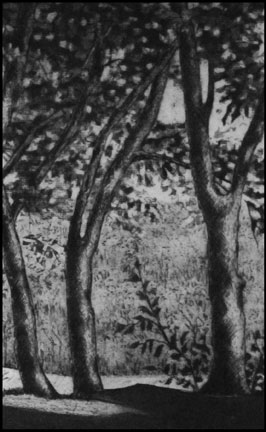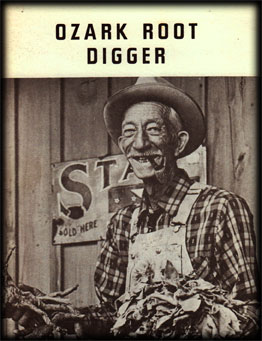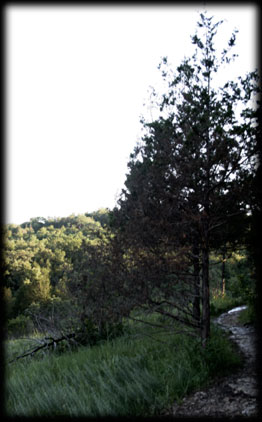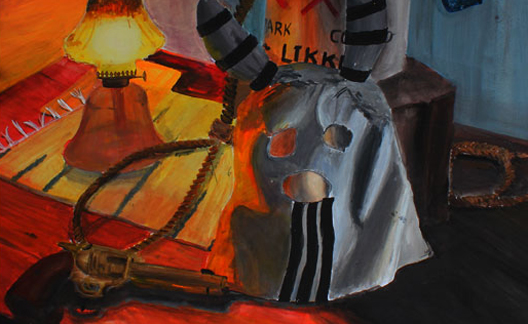Bald Knobbers and Outlaws
The post-civil war Ozarks was a place far removed from the region we now know. Most think of the Ozarks today in terms of natural beauty, country music, fishing, summer traffic, Christmas lights.
But not long ago, the place was a battlefield. It is humbling to realize that the Ozarks of the late nineteenth century more closely resembled a war-torn third world nation than a civilized country.
And perhaps there's some inspiration therein.
End of the Bald Knobbers
From Chick Allen
The end of the Baldknobber was in Christian County, around Ozark, Missouri, and was a gruesome a story as history has to tell:
On March 11, 1888, a farm family in Christian County was aroused by screams and gunfire from the home of their nearest neighbor. The elderly man ran to the home with a pounding heart and through the open door in the light from the fireplace, saw bodies over the floor, bleeding and moaning.
There had been eight of the family and relatives staying all night in this 16-foot cabin.
The farmer’s son was dead and also the eldest man of the family lay with his skull split with a bloody axe laying nearby.
Before being injured, his daughter tore the mask from the marauder and clutched it in her hand — the mask bore ugly horns and weird markings. It was evident that the culprits were the Baldknobbers. As possible, the sheriff and prosecuting attorney arrived with the coroner from Ozark, the county seat of Christian County.
The sheriff picked up the shotgun that was left on the floor and examined it, finding a crack in the shape of an “S” on the stock.
One man had been able to shoot a Baldknobber in the leg before he was hit with an axe. The daughter was questioned about the man who wore the mask she had grabbed, and she said she did not know him but he was young and had no beard or mustache.
The sheriff could not find any reason for this terrible and cowardly atack. The Knobbers had tried to cover up the incident by hanging two young men who were suspicioned of having a part in this killing.
They knew this terrible murder must be solved.
The sheriff and prosecuting attorney knew the man who wore the mask was young and had a bullet wound in his leg — and they had the shotgun found on the floor. They knew this terrible murder must be solved so they decided to go to Sparta and try to locate a man with a wounded leg. They continued questioning people there and talked to an old man who repaired watches, sewing machines and guns.
The sheriff showed the gun to the old man and asked him if he had ever seen it before. “Wal, I can't be sure,” he said, “seems to me I ought to know it. Yeah, I recollect it now — a young fellow brought that gun in two or three months ago and wanted to swap it for a rifle that I had. Yeah, I remember the crack in the stock — shaped like an ‘S,’ but I did not swap with him because he wouldn't give enough.”
When the sheriff and prosecuting attorney left the shop they knew that the description fit a man the sheriff knew and that if they could find him — and if he had a wounded leg — they would have their man. They left their horses and cut throught the woods to the cabin of the man who had brought the gun into the repairman’s shop.
When they got in sight of the cabin, they saw a young man come out and start to saddle his horse; they saw how feverish he was with excitement. When the horse was saddled, he went back into the cabin and got a package and started to mount.
The sheriff told him to halt and edged in between him and the horse, asking him what he had in the package. "Nothing," said the young man and the sheriff stepped forward and grabbed the package from him.
He ripped off the covering and found a black Baldknobber mask. The man said it was not his, that he found it and did not have anything to do with the killings. The sheriff stated that he would have to go to jail anyway. He handcuffed him and told him he would change his mind about his story when the hill folks started to tear down the jail and threaten to hang him.
After he was in jail, they talked of a way of scaring him into talking, and decided the threat of hanging by the people scared him most and they would find a group of men they could trust and have them come to the jail on the pretense of hanging him.
When the men were outside the jail, the young man heard the words "Hang him," and he beceame more fearful and agreed to a confession if the sheriff would protect him.
He admitted that he was a Knobber and he named the band of Knobbers, one of them a deacon.
He said that they met on a bald near Chadwick the night before the killing. “We initiated a new member and then they were talking about how the farmer and his family had been shooting off their mouths about the Knobbers and that the old farmer had killed a dog and said he had killed a Knobber. And that is the reason they went to the farm house to teach them a lesson.”
He named about 25 men but said only a few went into the cabin. He named a young man named Bill who had been shot in the leg and who had his mask jerked off by the daughter of the old farmer.
Continued above right...
plate 1. Baldknobber Mask by artist Gage Becker.
Becker, recently graduated from high school and currently employed at Silver Dollar City, Becker has impressed many with his deep appreciation of Ozark culture and knowledge of Stone and Taney County history. It is with deep appreciation that Becker’s artwork is displayed above. — Joshua Heston

plate 2. Detail of Kerr Access of James River 1 in graphite by Robert “Bob”
Homesteading on the James:
My great-grandpa was the first to come to this area. He and his wife. I think their oldest son — my great-grandpa Roy Tilden — was 12 or 13 at the time. They were, I believe, from Ashtabula, Ohio. It was in the 1870s, following the Homestead Act. But they picked a place down by the James River, site unseen, which would be scary. They came down and started doing what they had to do to begin living there. When the time came for them to get their deed, Roy left the farm and walked to Springfield.
Now, this was after the Civil War and the area was fairly lawless. The Baldknobbers were already riding and some of the local folks did not want them to move into the area. This is the way I was told the story. Shots were fired at them at times when they were plowing. And there were rumors that the Baldknobbers were going to burn them out. One evening, my great-grandpa was on the porch with his rifle. And a rider comes up at night as says, "Is this the Tilden Place?" And my grandpa says, "Yep" and cocks the gun. The rider leaves and there was no more said about the Baldknobbers burning them out.
— John Tilden, Reeds Spring, Missouri

plate 3. These stories were first written and published by Chick Allen in 1975.
Pictured below, Allen is remembered as an Ozark historian and “root digger” a founding member of the Baldknobber Music Show, and, perhaps most importantly, as a deeply respected and loved father and grandfather.
It is with great appreciation to John Fullerton — Chick Allen's great grandson and Branson historian — that this excerpt is published.

plate 4. Trail alongside Dewey Bald Mountain. 6/30/08 Photo credit, J. Heston. Location: Paul & Ruth Henning Conservation Area.
“Bald Mountain was another meeting place of the Baldknobbers in Stone County. Wash Gibbs was the out-law leader in Stone County. He lived in a log cabin in the valley of Roark Creek at the front of Dewey Bald. Another meeting place was atop Scissors Bald Montain in Taney County. There was a hiding place in a circle of rocks on top where the Civil War soldiers made bullets of lead and this was a look-out for anyone who might interfere.” — Chick Allen
End of the Baldknobbers (Continued):
After the confession, the Knobber was hauled off to Springfield jail and soon 25 men were arrested and confined under heavy guard in an old hall in Ozark (as the jail was too small).
“One of the men escaped. The others began squealing on each other.”
One of the men escaped. The others began squealing on each other.
The grand jury in Ozark started a serious investigation and the charges ranged from unlawful assembly to first-degree murder. The man who escaped was tricked into going to West Plains by a so-called friend to see his sister and the sheriff was there to meet him. He was arrested and sent to jail with the others to await trial. In March — a year after the murders — the trials began.
The young escapee was the first to be tried. Three of the Knobbers turned state's evidence to save their own skins. It was proven that the shotgun belonged to the young escapee and the older farmer's daughter identified him as the man she had unmasked. He still carried a scar on his leg where the bullet had ripped into it.
The defense attorney tried to impress the jury that the boy was only 17 years old but it did not impress them — he was found guilty and sentenced to death. Four men, including the deacon, were sentenced to hang by the neck until they were dead. The balance of the men pled guilty and received sentences from a few months to 25 years in the penitentiary. The supreme judges upheld the decisions of the Ozark court as they were all guilty of comitting barbarous murders.
The morning after the prisoners were told of this decision, the sheriff found a hole in the wall of the jail. The deacon and a member of his family were missing. A posse was formed and a reward offered for the capture of the two men. The next day, a farmer captured the deacon and returned him to Ozark but the other man was never seen again. On May 10, 1889, the three men were handcuffed and led up to the scaffold platform, and black hoods were placed on their heads and the ropes were fitted about their necks.
This was the sheriff’s first hanging and he built the scaffold with three nooses and one large trap door so all men would be hanged with one drop. He wanted to get it over with as soon as possible.
“They were thrashing around, choking to death.”
He pulled the lever and the men fell through. There was a terrible groan from the spectators and the sheriff looked down through the trap door and saw that the ropes were too long. The men's feet were on the ground and their necks were not broken. They were beating and thrashing around, choking to death. The sheriff grabbed the deacon's rope and managed to get him off of his feet and he choked to death.
Then he grabbed another rope and swung the man high enough that his feet did not touch the ground. The crowd moaned and many fainted. Then the sheriff grabbed the rope of the escapee and tried to swing him but the rope slipped off his head with the black hood. The youth fell to ground, thrashing around, his eyes wild with pain. Blood ran from his mouth and he cried, “Get it over with!”
The sheriff got some help and put the young man back up through the trap door where the rope was again fitted around his neck. The lever was jerked again and the youth went through the second time. The sheriff heard a terrific scream from the crowd and looked again through the trap door and saw the rope had again stretched too long for a second time. He grabbed the rope but by this time he did not have enough strength to lift him.
So the remaining Baldknobber was left there and after 16 minutes, he choked to death. So ended the Baldknobber reign of terror in the Ozarks. Their deaths were as agonizing as the crimes they had brought on the helpless people of the Ozark hills.




